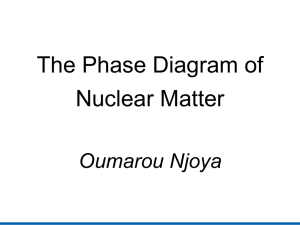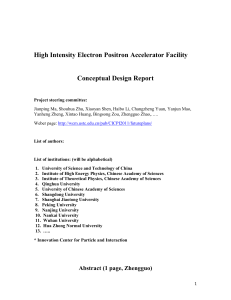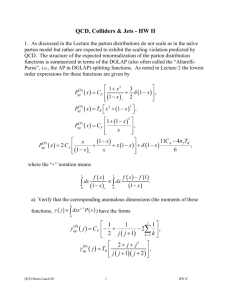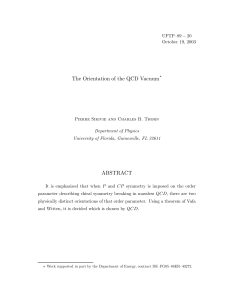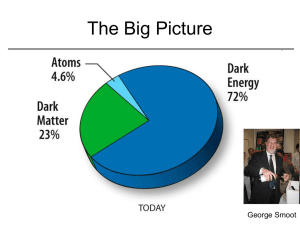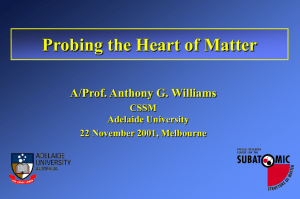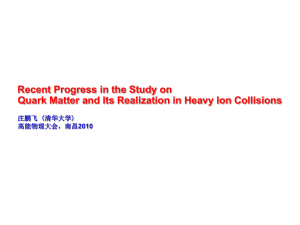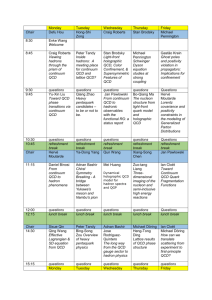edwards_talk_scidac_09 - JLab Computer Center
advertisement
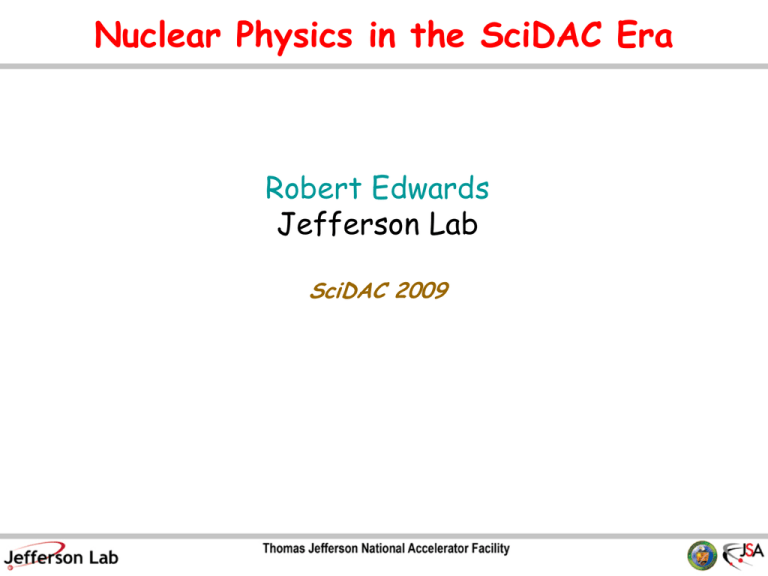
Nuclear Physics in the SciDAC Era Robert Edwards Jefferson Lab SciDAC 2009 Comparison of Chemistry & QCD : K. Wilson (1989 Capri): “lattice gauge theory could also require a 108 increase in computer power AND spectacular algorithmic advances before useful interactions with experiment ...” • ab initio Chemistry • ab initio QCD 1. 1930+50 = 1980 2. 0.1 flops 10 Mflops 3. Gaussian Basis functions 1. 1980 + 50 = 2030?* 2. 10 Mflops 1000 Tflops 3. Clever Multi-scale Variable? “Almost 20 Years ahead of schedule!” *Fast Computers + Smart Algorithms + Rigorous QCD Theoretical Analysis = ab initio predictions Forces in Standard Model Nuclei Weak N=2 (Isospin) Atoms: Maxwell N=1(charge) proton electron + neutron + quarks Standard Model: U(1) £ SU(2) £ SU(3) Sub nuclear: Strong N=3 (Color) Quantum Chromo Dynamics - QCD • QED: theory of electromagnetism • QCD: theory of strong interactions – hadronic physics QED QCD Photon, Gluons, G Charged particles, e, , u, d,… Quarks: u, d, s, c, b, t 2 charges: positive & negative Photon is neutral e ' 1/137 3 charges: “red”, “green”, “blue” Gluons carry color charge s ' O(1) • Highly non-linear theory – can only use perturbation theory at high energy Quark+anti-Quark in Meson Energy in glue 3 Color 3 quarks in Proton QCD • QCD: Dirac operator: Aº (vector potential), m (mass), °º (4x4 matrices) • Lattice QCD: finite difference • Probability measure: • Observables: Gauge generation How to produce gauge fields? • Hamilton’s eq’s - 1st order coupled diff. eq’s) • Bummer! – Must be “reversible” – No adaptive time steps Momentum Total energy in gauge/quark fields Cost Scaling • Cost: reasonable statistics, box size and “physical” pion mass • Extrapolate in lattice spacings: 10 ~ 100 PF-yr PF-years USQCD National Effort • US Lattice QCD effort: Jefferson Laboratory, BNL and FNAL FNAL BNL Weak matrix elements RHIC Physics JLAB Hadronic Physics SciDAC – R&D Vehicle Cluster Prototyping Software R&D Impact on DOE’s Nuclear Physics Program SciDAC Software QCD friendly API’s/libs • Application codes • High level (Linpack-like) • Data parallel (C/C++) • Linear algebra, threading, comms • Code generators http://www.usqcd.org QDP/C++ Expressions Can form expressions: ci(x) = Uij(x+nu) bj(x) + 2 di(x) for all sites x QDP++ code (data-parallel) multi1d<LatticeColorMatrix> U(Nd); LatticeFermion c, b, d; int nu, mu; c = shift(u[mu],FORWARD,nu)*b + 2*d; Template based Shifts use QMP for face comms Level-1 BLAS-like linear algebra core Critical code: Dirac operator/inverter • Critical codes: develop special API and libraries • Example: Dirac operator [ ] Threading/Multi-core • Hybrid threads/MPI • Impact: – Coalesce messages – Better perf. – Cachecoherency latency EXPENSIVE Scaling on Cray XT4 (ORNL) Socket level threading improved performance threads+mpi mpi Work involving RENCI Acceleration • Deflation & multigrid – big speedups JLab/W&M (SciDAC) + TOPS Nuclear Physics & Jefferson Lab CD-3 JLab Receives DOE Approval to Start Construction of $310 Million Upgrade • • Lab doubling beam energy Adding new experimental Hall Nuclear Structure • Fundamental questions – Size, shape, distribution of charge and current in hadrons – Quark and gluon distributions – How does nucleon spin arise from quarks and gluons? – What role do strange quarks play in nucleon structure? • Status – Basic nucleon properties calculated with 5-10% precision. – Pursuing higher precision, more demanding properties. • NP 2014 milestone – Perform lattice calculations in full QCD of nucleon form factors, low moments of nucleon structure functions and low moments of generalized parton distributions, including flavor and spin dependence. Nuclear Structure Spin of the proton? ~41% quark spin (u+d) ~0% orbital So: ~59% from glue (&/or strange) Most of mass & spin not from quarks Caveats: • Missing terms (disconnected) Phys. Rev. D77 094502 Spectroscopy Spectroscopy reveals fundamental aspects of hadronic physics. – Essential degrees of freedom? – Gluonic excitations in mesons - exotic states of matter? • Status. – Can extract excited nucleon energies & identify spins, – Pursuing calculations in full QCD with realistic quark masses. • Crucial complement to 12 GeV program at JLab. – Excited nucleon spectroscopy. – GlueX: flagship search for gluonic excitations. Nucleon spectrum NP2012 milestone: • Spectrum & E&M transitions up to Q2 = 7 GeV2 Highly excited energies: First ever lattice calculation Pattern of states -> Future work: – Separate out decays – Move to physical regime Possible 5/2- state ½+ 3/2+ 5/2+ ½- Phys. Rev. D79 034505 3/2- 5/2- Exotic matter? QED QCD Can we observe exotic matter? Excited string Spectroscopy • Charmonium excited spectrum: J-+ • Exotic matter (1-+) radiative decay: large Unknown in experiment GeV Phys. Rev. D77 034501 & to appear PRD If true with light quarks: Can observe at future JLab Hall D!! Outlook • Software infrastructure developed for Lattice QCD – Enabled effective utilization of INCITE resources • Lattice QCD’s impact on Nuclear Physics – Nucleon structure (protons, neutrons) – Spectroscopy • Results relevant to U.S. DOE experimental programs • Unifying Nuclear Physics research

